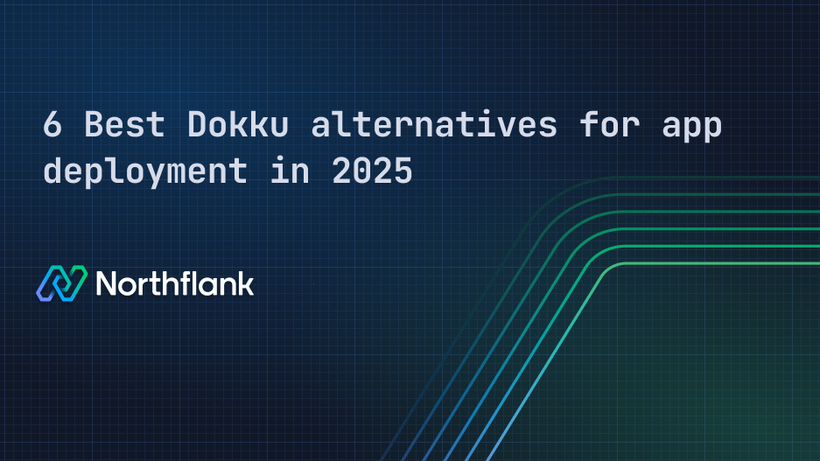

Talking IDPs, PaaS, and Developer Experience (DX) on the Tech Lounge Podcast
Back in September 2024, I joined Chris Ward on the Tech Lounge podcast at Civo Navigate Berlin to talk about how Northflank is building the next generation of developer infrastructure.
The episode covers everything from multi-cloud deployments to our use of Kata containers and how we started out by deploying game servers on bare metal at age 11. Here’s a recap of the main takeaways:
There’s a crowded field of platforms claiming to “focus on developer experience.” But most of them are either glorified dashboards or shallow abstractions that break the moment you try to do something complex. We’ve spent five years going deep AND broad, building a platform with serious depth that works for real production workloads.

Northflank is a post-commit platform to self-serve apps, databases, and jobs to any cloud. You can use our managed infrastructure, or plug in your own AWS, GCP, Azure, or even a private OpenShift cluster. You get consistency across environments, and the ability to scale from hobby projects to teams running thousands of microservices.
Most infrastructure tools still think in terms of primitives: EC2 groups, load balancers, Kubernetes clusters. We don’t. Northflank speaks the language of workloads.
Developers don’t want to provision a VPC. They want a Postgres database, a preview environment for their app, a cron job that just works.
That mindset shift drives everything we do. You push code, we build, deploy, manage logs, metrics, autoscaling, failover, and more.
Multi-tenancy is hard to do well, and most people get it wrong. From day one, we’ve treated untrusted code execution as a security problem and a cornerstone of Northflank’s platform, not a feature. We initially used gVisor, but migrated to microVMs with Kata Containers to balance security and performance with support for QEMU, Firecracker, and Cloud Hypervisor. For edge cases (like public cloud not supporting nested virtualization on some hardware, such as GPU node types and non-metal nodes on AWS), we still support gVisor.
You don’t want tenant A snooping on tenant B because someone cut corners with container isolation.
We have strong opinions about defaults—Istio for service mesh, sane CI/CD workflows, one-click preview environments. But we’re not dogmatic. If you want to bring your own logs, secrets manager, DNS, GPU workloads, or even your own cloud, we support it.

It’s a “pick and mix” model. Start with the golden path. Escape when needed.
The same platform that powers complex enterprise workloads also supports parents deploying glucose monitor dashboards for their kids.
They click a template, configure a couple variables, and deploy. No infra experience required. At the other end of the spectrum, we’ve got platform teams building full internal platforms on top of our API surface. Same platform.
Our APIs are fully exposed. Every action in the UI is mirrored in our CLI, REST API, and GitOps layer. It’s why platform teams trust us to run thousands of workloads.
My co-founder and I met playing games online when we were 11. We were hosting game servers on Hetzner and OVH, duct-taped together with Bash scripts. It was slow, painful, and fragile.
Later, we learned to code and built our own game server hosting platform. We used Rancher. Then Mesos. We were early to containers. But we eventually realized that if you can containerize a game server, you can containerize everything: databases, jobs, production apps, CI/CD workflows.
Northflank is the platform we wish we had then. One place to define and deploy workloads with speed and security, across any environment.
We offer a generous free tier called the Developer Sandbox. You can deploy apps, databases, and jobs on our infrastructure, for free. If you want to use your own cloud, go for it.
We built Northflank for engineers who’d rather ship than stitch together infra. If that’s you, try it out.
You’ll find the full conversation (lightly edited for clarity) below.
Chris: Welcome to the Tech Lounge. My guest today is Will Stewart, CEO and co-founder of Northflank. We recorded this at Civo Navigate Berlin back in September 2024. Since then, Northflank has raised $22 million. Congrats on that. Let’s start from the top: Northflank is in a pretty crowded space. What exactly do you offer that’s different?
Will: At a high level, Northflank is a self-service platform for developers to deploy apps, databases, and jobs to the cloud. But we don’t think in terms of infrastructure, we think in workloads. Developers don’t want to create EC2 groups or Kubernetes clusters. They want Postgres, Mongo, Redis, or a preview environment for their app. That’s what we provide: a post-commit platform to build, deploy, and operate workloads with minimal friction.
Chris: So under the hood, you’re using Kubernetes?
Will: Yes, Kubernetes is our operating system. But the developer never needs to touch it. They can deploy on our managed infrastructure, or connect their own AWS, GCP, Azure, whatever they need. We take care of the lifecycle, automation, and developer experience on top of that.
Chris: Do you also offer your own cloud?
Will: Our managed product runs on Google Cloud and Azure. We operate large clusters and layer our secure runtime on top using Kata Containers, Cilium, and Istio. It’s multi-tenant, secure, and production-ready. And yes, we just hit general availability for our Civo integration, you can provision a production-ready workload platform on Civo in under 10 minutes.
Chris: What makes Northflank stand out from other PaaS or platform tools?
Will: Most tools in this space say they “focus on DX,” but don’t back it up. Northflank exposes every feature across UI, API, CLI, and GitHub integrations. Some of our enterprise customers chose us because we were the only platform offering that level of abstraction and control. We’re not just a dashboard over Kubernetes—we’ve built deep functionality around real developer workflows.
Chris: Do you see your main competition as other platforms, or DIY setups?
Will: Honestly, 99% of the time, our competition is DIY. Teams write their own Terraform, run their own Helm charts, stitch it all together. They’re doing that because there hasn’t been a credible alternative that’s flexible and complete enough. That’s our opportunity. If a platform only solves 85% of your needs, it’s not enough. We aim to get much closer to 100% by working tightly with our customers.
Chris: Why Kata Containers?
Will: Security. In a multi-tenant platform, you’re running untrusted code. You can’t rely on basic container isolation. We started with gVisor but hit performance issues. Kata gives us hardware-level isolation with better performance. We’ve deployed millions of pods in production using it.
Chris: What about users who don’t want Kata or can’t use nested virtualization?
Will: We still support gVisor for environments where Kata isn’t viable—like non-metal AWS nodes or certain GCP AMD configurations. We maintain a matrix of what works best depending on cloud, CPU type, and price-performance tradeoffs.
Chris: You use Istio for service mesh by default. Can users bring their own mesh?
Will: By default, it’s Istio, but yes, we support alternatives like Linkerd for customers who need it. We offer a golden path that works out of the box, but customers can customize everything: logs, DNS, secrets, GPUs, service mesh, cloud provider. You can even run Northflank on your own data center or OpenShift cluster.
Chris: And what about monitoring and logging?
Will: If you run on our infrastructure, we handle it. If you need data residency or privacy guarantees, you can plug in your own logging and observability stack. Bring-your-own-everything is something we support—BYO logs, secrets, cloud, GPU, etc.
Chris: You mentioned earlier that some pretty different kinds of people are using Northflank. What’s the range?
Will: We’ve got platform teams managing thousands of microservices. But we also have mothers deploying glucose monitoring dashboards for their kids. There’s an open source project that uploads glucose data to a database and visualizes it. With Northflank’s free tier, they can deploy that with one click, no infra experience required.
Chris: Let’s go back to the beginning. Why did you start Northflank?
Will: It started when my co-founder and I were 11. We met playing online games and started deploying game servers on Hetzner and OVH using Bash scripts. It was painful, but we learned a lot. Later, we built a game server hosting platform on Rancher, then on Mesos. Eventually, we realized if you can containerize a game server, you can containerize anything—databases, microservices, CI/CD pipelines.
Chris: Do you still use Northflank to run game servers?
Will: We’ve run some Minecraft servers on it, yeah. Kubernetes didn’t play well with UDP until recently, but it’s getting better.
Chris: You mentioned the shift between public and private cloud. Are you seeing that among customers?
Will: It’s all over the place. Some are moving off public cloud to private. Others are going the other way. Some are trying to do hybrid. The consistent thing is that nobody wants to throw away their investment, especially in data centers. With Northflank, if you can get us a Kubernetes endpoint, we can install and run the platform.
Chris: Is multi-cloud something your customers care about?
Will: Depends what you mean by multi-cloud. Some want active-active across providers. Others want DR in a second region or cloud. Some have teams in different orgs using different clouds. We support all of that. The goal is: no matter where you're running, the workflow stays the same.
Chris: And your pricing?
Will: Usage-based. If you're on your cloud, pay us a fraction of what you pay your provider—roughly 10%. If you’re using our infra, it’s metered too. We’re about half the price of Heroku and ~30x cheaper than OpenShift.
Chris: Where can people try it?
Will: https://northflank.com/. You can start with the Developer Sandbox, fully featured and free on our cloud. Or book a demo here.
Chris: Awesome. Thanks, Will.
Will: Appreciate it. Thanks for having me.


